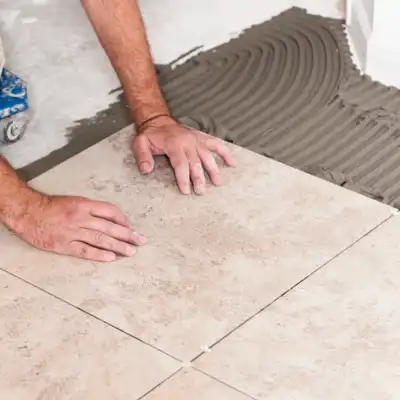Raise Your Area: Expert Tile Installation Austin, Texas
Raise Your Area: Expert Tile Installation Austin, Texas
Blog Article
Discover the Tricks to Perfect Ceramic Tile Installment Each Time
Mastering the art of floor tile setup entails a series of accurate actions and methods that, when carried out correctly, can result in a seamless and refined surface. By recognizing the keys behind each action, you can guarantee that your ceramic tile installation not only fulfills however exceeds your expectations.
Proper Surface Area Preparation
Efficient tile installation hinges dramatically on meticulous surface area prep work to ensure a perfect end result. The surface area must be clean, completely dry, and structurally sound to stop future concerns such as loosened tiles or fractured cement.
To assure proper bond, it is advised to rough up smooth surfaces through sanding or scarifying. In addition, using a guide can improve bonding between the tile and the substrate adhesive. Uneven surfaces need to be leveled utilizing a self-leveling substance to protect against lippage and make sure a smooth finish.
Additionally, looking for potential resources of dampness is vital, as excess wetness can bring about mold and mildew growth and damage the tiles over time. Making use of a dampness barrier or waterproofing membrane in wet locations like cooking areas or restrooms is necessary to protect the floor tiles from water damages. By thoroughly preparing the surface before tile setup, one can develop a long lasting and aesthetically appealing tiled location that will stand the test of time.

Choosing the Right Adhesive
Selecting the proper adhesive is an important action in ensuring the successful installment of tiles. The type of glue you pick will depend upon numerous elements such as the sort of tile, the substratum material, and the place of the installment. There are different kinds of adhesives available on the market, consisting of thin-set mortar, mastic, and epoxy.

Epoxy adhesives are incredibly durable and water-resistant, making them ideal for areas susceptible to moisture such as cooking areas or restrooms. They are also ideal for mounting glass or steel ceramic tiles. When choosing an adhesive, make sure to adhere to the producer's referrals and consider the specific requirements of your floor tile setup project.
Precision Reducing Methods
One of the most common tools used for precision cutting in floor tile installation is the ceramic tile cutter. Floor tile cutters come in different kinds, consisting of manual ceramic tile cutters, electrical wet saws, and handheld ceramic tile cutters. Hand-operated tile cutters are ideal for straight cuts on ceramic and porcelain floor tiles, giving tidy and exact sides.
Furthermore, making use of devices like ceramic tile scribes or glass cutters can assist in racking up and snapping floor tiles with accuracy. By grasping these precision cutting methods, floor tile installers can guarantee an expert finish and an aesthetically attractive result in their tile jobs.

Grout Application Tips
When transitioning from accuracy cutting methods to grout application in tile setup, focus to detail and strategy is extremely important for achieving a flawless coating. Cement offers not just as a practical element that fills the voids between floor tiles but additionally plays a significant role in the total aesthetic of the installment.
When using cement, operate in small areas at once to stop it from drying too promptly. Use a rubber float to push the cement right into the joints at a 45-degree angle, making sure complete coverage and condensing the material. When the grout is used, utilize a damp sponge to cleanse the tiles, making click site certain not to eliminate grout from the joints. Buff the tiles with a completely dry fabric to eliminate any haze and attain a polished surface. Complying with these cement application suggestions will result in a skillfully installed ceramic tile surface area that improves the beauty of any kind of space.
Ending Up Touches and Upkeep
To finish the tile installment job properly, interest to information throughout the ending up touches and normal maintenance is important. After the cement has actually dried out and the ceramic tiles are safely in place, the last actions entail guaranteeing that all sides are correctly sealed. Applying a high-quality sealant around the border of the tiled location helps protect against water damage and lengthens the life of the setup. In addition, checking for any loosened tiles or cement and addressing them immediately can stop extra substantial issues down the line.
Regular upkeep is vital to protecting the charm and performance of your tiled surface areas. A straightforward routine of sweeping or vacuuming complied with by mopping with a mild cleaner can assist maintain your ceramic tiles looking beautiful (tile installation austin). For areas that are frequently revealed to wetness, such as bathrooms or kitchens, normal resealing of cement lines is recommended to stop mold and mildew and mold growth
Final Thought
Finally, see here now achieving excellent tile setup each time calls for focus to information and proper techniques. By concentrating on surface prep work, selecting the right adhesive, utilizing precision cutting approaches, using cement thoroughly, and completed with attention to detail, you can make certain a professional-looking result. Keep in mind to adhere to these steps and keep your floor tiles regularly to extend their lifespan and maintain them looking their finest.
One of the most usual tools utilized for accuracy cutting in tile installment is the tile cutter. Ceramic tile cutters come in numerous types, including manual ceramic tile cutters, electrical damp saws, and handheld ceramic tile cutters. Hands-on floor tile cutters are visit this site right here appropriate for straight cuts on ceramic and porcelain tiles, supplying precise and clean sides. In addition, using tools like ceramic tile scribes or glass cutters can assist in racking up and breaking ceramic tiles with precision. By mastering these precision cutting methods, tile installers can make certain a specialist coating and an aesthetically attractive result in their tile tasks.
Report this page